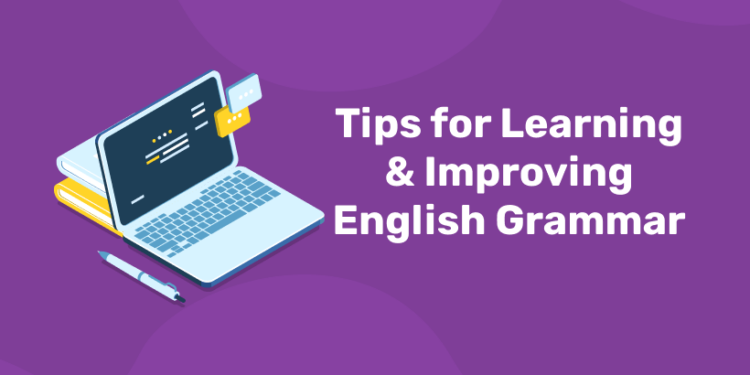Table of Contents
Grammar is a system that builds language, and every language has its own guidelines. But grammar has little to do with rules as they are principles that determine how we speak and write, and it includes such things as spelling, variation of words for different purposes, and the way words are arranged to form a sentence. While it is good to remember that languages are constantly evolving organisms, it is also important to know that a proper grammar is still needed for communication. Fortunately, there are many resources and style guides available to help people who want to improve their grammar.
Grammar can be a stressful topic for most people as we have a lot of confusing and complicated rules. However, the use of good grammar is important in school and can serve as a first impression of how people will judge your ability and success in writing. So, it helps to know some basic tips for improving your grammar, so let’s get started.
Grammar is an English skeletal structure. Without grammar, one cannot continue to learn or improve one’s English. Therefore, you need to know the basics of tip-to-toe grammar. Now, improving your grammar is not rocket science. One can easily improve one’s grammar with some simple tasks.
However, it is a reminder that one cannot learn or develop grammar in just one day. It is a long, ongoing process. But, don’t worry, we are here to help you. Follow these simple tips to start your journey and improve your grammar.
Part1: Learning the Basics of Grammar
-
Know the parts of speech
These are the kinds of words that make up language, and they are nouns, adjectives, pronouns, verbs, adverbs, adverbs, conjunctions, conjunctions, and sometimes passages. To put sentences together correctly, you need to understand what parts of speech are and how they work in sentences.
- Nouns are the elements that usually perform the action in a sentence, such as a person, place, thing, idea, emotion, animal, or event. Nouns include Sally, Paris, sand , philosophy , happiness, dog, and birthday.
- Adjectives modify nouns and describe aspects or characteristics of nouns. Adjectives include red, funny, lazy, large, and short.
- Pronouns take the place of nouns. There are personal subject pronouns (such as I, she, and they), personal object pronouns (such as us, you, it, and them), personal possessive pronouns (such as mine, yours, his, hers, and theirs), and relative pronouns (such as who, which, that, and whose).
- Verbs indicate actions or states of being and tell what the noun is doing. Verbs include run, sing, type, be, and walk.
- Adverbs modify verbs, adjectives, conjunctions, prepositions, and other adverbs. They are words like quickly, well, and slowly. These words often end in –ly.
- Prepositions indicate relationships in time, space, or direction. Prepositions include to, in, on, over, of, and across.
- Conjunctions join nouns, clauses, phrases, and sentences. Coordinating conjunctions link independent clauses, and they are for, and, nor, but, or, yet, and so (remember FANBOYS). Subordinating conjunctions link dependent clauses, and they include because, if, since, while, and although.
- Interjections are words that indicate emotions. These include oh, hey, ouch, and wow. They are often followed by exclamation points.
- Articles are used to modify and define nouns. The is a definite article, and a and an are the indefinite articles.
-
Recognize points of view
According to grammar, English has three concepts, and each of these can be singular or plural. The points of view are: singular or plural first person, singular or plural second person, and singular or plural third person. The correct pronouns are:
- First-person singular: I
- Second-person singular: you
- Third-person singular: he (masculine) / she (feminine) / it (neuter)
- First-person plural: we
- Second-person plural: you
- Third-person plural: they
-
Use proper word order
English sentences are formed by the subject-object-object (such as “Andrea ran to the door,” not “Run to the door Andrea”). Usually, titles precede adjectives, and adjectives precede nouns that change them. Converters should always be placed as close to their names as possible. For example:
- Frank (subject) quickly (adverb) mailed (verb) the (article) long (adjective) letter (object).
-
Conjugate verbs properly
English technically only combines the present (“I like”) with the past tense (“I liked”), which means that English verbs are only changed (with different forms or endings) for these tenses. However, some action verbs, such as the future (“I will love you”), are created with the help of emotions, words that indicate the time (such as “tomorrow”), and auxiliary words (help) and actions. Using the verb “to walk” as an example, some of the key moments in English are:
- Simple present (uninflected verb, or verb + s/es in third person): I go, you go, he/she/it goes, we go, you go, they go.
- Present continuous (aka progressive) (am/is/are + present participle): I am going, you are going, he/she/it is going, we/you/they are going.
- Present perfect (has/have + past participle): I have gone, you have gone, he/she/it has gone, we/you/they have gone.
- Simple past (verb + –ed for regular verbs): I/you/he/she/it/we/you/they went (“to go” is an irregular verb).
- Past continuous (was/were + present participle): I was going, you were going, he/she/it was going, we/you/they were going.
- Past Perfect (had + past participle): I/you/he/she/it/we/you/they had gone.
- Simple future (will + uninflected verb): I/you/he/she/it/we/you/they will go.
- Future continuous (will be + present participle): I/you/he/she/it/we/you/they will be going.
- Future Perfect (will have + past participle): I/you/he/she/it/we/you/they will have gone.
-
Punctuate sentences properly
Punctuation is an important part of language because it signifies start, stop, pause and relationship. Capitalize the first letter of every sentence, and the first letter of all the correct nouns (names of people and places). The main punctuation marks in English — and their basic use — are:
- Commas separate thoughts, ideas, elements, and independent clauses.
- Periods indicate the end of a sentence.
- Semicolons join independent clauses in a single sentence or separate elements in a list.
- Colons introduce items in a list, explanations, or definitions.
- Question marks indicate that a question was posed.
- Exclamation points show emphasis, imperatives, or declarations.
- Apostrophes demonstrate possession or create contractions.
- Quotation marks indicate that you are directly quoting someone else’s words.
- Hyphens join separate words into compound words, modifiers, and numbers.
- Dashes create a pause, interrupt a sentence, or add parenthetical information.
- Parenthesis add additional information, references, or citations.
Part2: Practicing Grammar
1: Which of the sentences below is grammatically correct?
-
Read children’s books
Although children’s books may not be grammar books, they are designed to teach the basics of language, including basic words and spelling, common and unusual nouns and verbs, simple combinations, and sentence structure. Children are seldom taught explicitly the grammar and resources of their native languages, but rather, they take them by learning and listening to other native speakers.
-
Read a variety of material
Improve your grammar by learning how other writers use language. Focus on learning different types and styles of writing, such as classic books, textbooks, science fiction, science fiction, biography, blogs, essays, and essays. Pay attention to the structure of sentences, word order, spelling, and the variety of art forms used by writers.
- Try to read aloud so that you too can get an idea of how the language sounds in a conversation.
- Keep a dictionary and thesaurus close at hand while you read.
- Read the newspapers, listen to the news radio, and watch daily television news programs.
-
Pay attention to how other speakers talk
Listen to how some people form sentences, put words in sentences, say common phrases, and vocabulary they use. English has many rules and variations, so don’t be afraid to ask questions if you have any.
- Try to explain what other people mean by repetition so that you can understand how sentences are formed and expand your vocabulary.
- Note that some English-speaking people, even indigenous peoples, are not fluent in grammar.
-
Play word and grammar games
There are many online games and apps you can download to your computer or phone that will test your language skills in a fun way. As these games teach, they will often provide explanations of the wrong answers so you can learn from your mistakes.
- Libraries, bookstores, and online resources will also provide grammar lessons, exercises, and quizzes.
-
Practice writing every day
Improve your grammar by writing and practicing any new rules or words you have learned. Keep a journal, write short stories, or just email back and forth with friends or family. Focus on improving any problem areas that you may have or mistakes that you often repeat.
- Do not rely solely on system inspectors. Otherwise, they may be wrong. Second, you will not learn from your mistakes if you do not fix the job yourself. If you use a grammar check or debugging tool, take the time to look at what changes you have made to learn what you did wrong.
Spoken English Course for Guaranteed Confidence and Career Growth
Spoken English Course by Entri App: Enhance your communication skills, gain certification, and boost your career with confidence.
Join Now!Part3: Avoiding Common Mistakes
-
Learn the difference between confusing words
English has many words that look, sound, and / or spell the same way, even though they have very different meanings. These homographs (synonyms), synonyms (similar words), heteronyms (words spelled the same but pronounced differently), and homonyms (words that are spelled the same way and are pronounced the same) cause a great deal. of confusion, and causes common mistakes. Remembering these common mistakes will help you avoid frequent mistakes. Common errors include:
- Confusing it’s (a contraction of it is) and its (a possessive pronoun).
- Mixing up they’re (a contraction of they are), their (a possessive pronoun), and there (an adverb indicating place).
- Using you’re (a contraction of you are) and your (a possessive pronoun) incorrectly.
- Confusing too (which means in addition), to (a preposition) and two (the cardinal number that comes after one).
- Not using then (meaning at that time) and than (used to compare) correctly.
- Improperly using lie (meaning to be in a horizontal position) and lay (which means to place something in a horizontal position).
- Confusing farther (used with physical distance) and further (used with figurative or metaphorical distance).
-
Use punctuation properly
Incorrect punctuation may indicate that the meaning you are trying to convey may be confused or lost. There are many typographical errors that can occur in English, including:
- Progressive sentences, where there are no punctuation marks that separate the individual clauses in the same sentence. This can be corrected by setting semicolon or time between individual categories.
- Comma splices,where the individual clauses in a sentence are connected with a comma but without the proper linking conjunction. Instead of using commas, use commas followed by the word “once” or “but.”
- Using apostrophes to form the plural (used to build access or to show having, not to create plural).
- Misuse of quotation marks, which should only be used to show that you are directly quoting what someone is saying.
-
Use the active voice
In active construction, the subject is the object of action; in a synthetic structure, the subject is taken by an external force. While there is nothing wrong with a synthetic word, it is less powerful and can make sentences less clear. Therefore, you should use the active word often, but it is acceptable to use the active voice from time to time, especially to emphasize something. For example, consider how these active and passive sentences emphasize the different aspects of a sentence:
- The active “I paid the bill” places the emphasis on what the subject did.
- The passive “The bill was paid by me” places the emphasis on who paid the bill.
-
Use reflexive pronouns properly
Repeated pronouns are me, you, myself / us, us, yourself, and myself. These pronouns can be used spontaneously or in depth. Consent pronouns are only used as verbs in the sentence, and only if the object is the same as the subject. Deep nouns are used to add emphasis to a sentence and emphasize that the maker has done the action. To make a difference, remember that if a pronoun is not removed from a sentence and makes sense, the pronoun is often used. However, if the pronoun can be deleted without changing the meaning of the sentence, it is used interchangeably.
- Reflexive: “I pinched myself to see if I was dreaming.”
- Intensive: “She individually picked each gift herself.”
- Reflexive: “He asked himself how he’d feel in that situation.”
- Intensive: “I myself don’t know how I’d react.”
Part4: Finding Reliable Resources
-
Take a class or see a tutor or teacher
One of the best ways to ensure that you understand the basics of grammar is to get help from someone who is qualified to teach you. Many community colleges offer language courses, or you can inquire at your high school or college to see if there are any English students who want to make extra money by teaching you.
-
Read style guides and grammar books
Grammar and style guidelines come in two forms: descriptive guidelines for how people speak, and descriptive guidelines for telling people how to speak. But the language is changing and evolving, and English rules are not always set in stone. There are many style guides that recommend different ways to access the grammar, and it is a good idea to read a few of them. This will give you an idea of the different ways of dealing with spelling (such as American versus Britain), syntax, and style, give you a better idea of the basics of grammar, and show you where language is most adaptable and consistent. Some of the most commonly used style guides are:
- The Chicago Manual of Style, which is often used for social science and historical journals.
- The Modern Language Association (MLA) style, which is often used in the humanities, in language studies, and in cultural studies.
- The Associated Press (AP) style, which is used by most news and media outlets.
- The American Psychological Association (APA) style, which is often used for natural and life sciences, academic journals, and social sciences.
-
Find online resources
As well as resources available in libraries, the Internet is packed with reliable grammar games, tutorials, tests, quizzes, and tips. Most universities will provide resources on grammar, spelling, syntax, and general errors.
Although English can be much easier than other languages to learn basic, for example, no gender, no tenses, and very little verbal integration, it can be difficult if you want to speak as native and fluent. The best way to learn the most complex aspects of English is to practice with people from all over the world who speak English.
If you are learning English, you will probably learn British or American English depending on where you study, or who you study with. Although there is a difference between the two pronunciation and the spelling, most people have no problem understanding each other from any English-speaking country. So if you like to speak English Queen, practice with the Brit. If you like to talk like a cowboy, train with Yank. Or if you like to talk like a kangaroo, train with the Aussie.
Thankfully, it’s increasingly comfortable to discover native speakers from all over the world to help you practice speaking English thanks to the Internet. The ENTRI Learning App is a good option for taking an online spoken English class and getting a conversation partner, however, it doesn’t give you many ways to find these partners. If you’re searching for a language exchange, there are a lot of sites you can check out online, however many of them unfortunately cost money, and aren’t so easy to use. And even then you still have to set a time with your new partner and remember to be there. But through our course “English Padikkyam with Inverted Coconut” you can talk with the mentor and other students through the voice practice groups.












